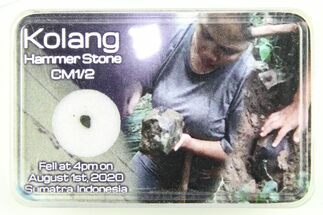This Specimen has been sold.
.17" Carbonaceous Chondrite Fragment - Cold Bokkeveld
This is quite the astronomical specimen: a .17" wide fragment of the Cold Bokkeveld meteorite!
Cold Bokkeveld is the name given to a meteorite that fell in the Kouebokkeveld ("Cold Buck Shrubland" in Afrikaans) mountain region in southwestern South Africa. It hit the Earth mid-morning on October 13, 1838: fragments fell in a strewn field around the area. Several eyewitnesses reported the fireball in the sky and the subsequent sonic boom, as well as fragments falling and smoking in the grass. It is the fourth largest observed CM2 chondrite fall in history with a total known mass of about 5.2 kilograms.
Cold Bokkeveld is a CM2 carbonaceous chondrite, a very rare and primitive kind of chondrite that has a nearly identical composition to the Sun, and about as old at 4.5 billion years! Like many CM2 chondrites, it is a handsome brecciated stone with whitish to gray clasts and chondrules set in a dark gray to black matrix. it also contains trace amounts of organic and volatile compounds, as well as evidence of hydrous minerals and calcium-aluminum rich inclusions (CAIs). This class of meteorite is incredibly rare and sought after for not just its beauty but its scientific value, giving researchers a rare look into the beginning of the solar system.
Cold Bokkeveld is a CM2 carbonaceous chondrite, a very rare and primitive kind of chondrite that has a nearly identical composition to the Sun, and about as old at 4.5 billion years! Like many CM2 chondrites, it is a handsome brecciated stone with whitish to gray clasts and chondrules set in a dark gray to black matrix. it also contains trace amounts of organic and volatile compounds, as well as evidence of hydrous minerals and calcium-aluminum rich inclusions (CAIs). This class of meteorite is incredibly rare and sought after for not just its beauty but its scientific value, giving researchers a rare look into the beginning of the solar system.
About CM2 Carbonaceous Chondrites
Carbonaceous chondrites are a rare and scientifically significant type of stony meteorite, representing only about 4% of all meteorites found on Earth. These meteorites are considered to be some of the oldest materials in the solar system, dating back over 4.5 billion years. They are composed primarily of silicate minerals but are unique for their high levels of carbon, organic compounds, and water-bearing minerals, offering a glimpse into the conditions of the early solar system.
Theys are divided into several groups, including CI, CM, CR, CO, CV, and CK, each representing different compositions and histories. CI and CM chondrites are the most primitive and are often rich in organic compounds. CI chondrites, like the Orgueil meteorite, are extremely rare and contain the highest known concentrations of organic materials among meteorites.
A CM2 chondrite is a type of carbonaceous chondrite meteorite with a high abundance of carbon and water-bearing minerals. The “CM” classification stands for the "Mighei-type," named after a meteorite that fell in Mighei, Ukraine. The "2" in CM2 indicates a specific petrologic (textural) type, meaning it has experienced low levels of alteration from water or heat compared to other chondrites, preserving more primitive materials.
Carbonaceous chondrites are a rare and scientifically significant type of stony meteorite, representing only about 4% of all meteorites found on Earth. These meteorites are considered to be some of the oldest materials in the solar system, dating back over 4.5 billion years. They are composed primarily of silicate minerals but are unique for their high levels of carbon, organic compounds, and water-bearing minerals, offering a glimpse into the conditions of the early solar system.
Theys are divided into several groups, including CI, CM, CR, CO, CV, and CK, each representing different compositions and histories. CI and CM chondrites are the most primitive and are often rich in organic compounds. CI chondrites, like the Orgueil meteorite, are extremely rare and contain the highest known concentrations of organic materials among meteorites.
A CM2 chondrite is a type of carbonaceous chondrite meteorite with a high abundance of carbon and water-bearing minerals. The “CM” classification stands for the "Mighei-type," named after a meteorite that fell in Mighei, Ukraine. The "2" in CM2 indicates a specific petrologic (textural) type, meaning it has experienced low levels of alteration from water or heat compared to other chondrites, preserving more primitive materials.
SPECIES
Carbonaceous Chondrite (CM2)
LOCATION
Kouebokkeveld Mountains, Cape Province, South Africa
SIZE
.17" wide
CATEGORY
SUB CATEGORY
ITEM
#285956
 Reviews
Reviews












